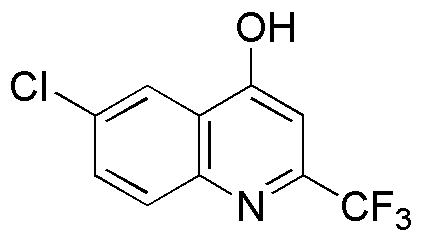6-Chloro-4-hydroxy-2-(trifluoromethyl)quinoline is widely utilized in research focused on:
- Pharmaceutical Development: This compound serves as an important intermediate in the synthesis of various pharmaceuticals, particularly those targeting bacterial infections and cancer. Its unique structure allows for modifications that enhance biological activity.
- Agricultural Chemicals: It is used in the formulation of agrochemicals, including herbicides and fungicides. The trifluoromethyl group contributes to increased potency and selectivity, making it effective against specific pests while minimizing environmental impact.
- Fluorescent Probes: The compound is employed in the creation of fluorescent probes for biological imaging. Its ability to absorb and emit light at specific wavelengths makes it valuable for tracking cellular processes in real-time.
- Material Science: In the development of advanced materials, this chemical is used to enhance the properties of polymers and coatings. Its incorporation can improve thermal stability and chemical resistance, which is crucial for industrial applications.
- Research in Biochemistry: It plays a role in biochemical research, particularly in studies related to enzyme inhibition. Understanding its interactions can lead to the development of new therapeutic agents that target specific biological pathways.
General Information
Properties
Safety and Regulations
Applications
6-Chloro-4-hydroxy-2-(trifluoromethyl)quinoline is widely utilized in research focused on:
- Pharmaceutical Development: This compound serves as an important intermediate in the synthesis of various pharmaceuticals, particularly those targeting bacterial infections and cancer. Its unique structure allows for modifications that enhance biological activity.
- Agricultural Chemicals: It is used in the formulation of agrochemicals, including herbicides and fungicides. The trifluoromethyl group contributes to increased potency and selectivity, making it effective against specific pests while minimizing environmental impact.
- Fluorescent Probes: The compound is employed in the creation of fluorescent probes for biological imaging. Its ability to absorb and emit light at specific wavelengths makes it valuable for tracking cellular processes in real-time.
- Material Science: In the development of advanced materials, this chemical is used to enhance the properties of polymers and coatings. Its incorporation can improve thermal stability and chemical resistance, which is crucial for industrial applications.
- Research in Biochemistry: It plays a role in biochemical research, particularly in studies related to enzyme inhibition. Understanding its interactions can lead to the development of new therapeutic agents that target specific biological pathways.
Documents
Safety Data Sheets (SDS)
The SDS provides comprehensive safety information on handling, storage, and disposal of the product.
Product Specification (PS)
The PS provides a comprehensive breakdown of the product’s properties, including chemical composition, physical state, purity, and storage requirements. It also details acceptable quality ranges and the product's intended applications.
Certificates of Analysis (COA)
Search for Certificates of Analysis (COA) by entering the products Lot Number. Lot and Batch Numbers can be found on a product’s label following the words ‘Lot’ or ‘Batch’.
Numéro de catalogue
Numéro de lot/série
Certificates Of Origin (COO)
This COO confirms the country where the product was manufactured, and also details the materials and components used in it and whether it is derived from natural, synthetic, or other specific sources. This certificate may be required for customs, trade, and regulatory compliance.
Numéro de catalogue
Numéro de lot/série
Safety Data Sheets (SDS)
The SDS provides comprehensive safety information on handling, storage, and disposal of the product.
DownloadProduct Specification (PS)
The PS provides a comprehensive breakdown of the product’s properties, including chemical composition, physical state, purity, and storage requirements. It also details acceptable quality ranges and the product's intended applications.
DownloadCertificates of Analysis (COA)
Search for Certificates of Analysis (COA) by entering the products Lot Number. Lot and Batch Numbers can be found on a product’s label following the words ‘Lot’ or ‘Batch’.
Numéro de catalogue
Numéro de lot/série
Certificates Of Origin (COO)
This COO confirms the country where the product was manufactured, and also details the materials and components used in it and whether it is derived from natural, synthetic, or other specific sources. This certificate may be required for customs, trade, and regulatory compliance.


